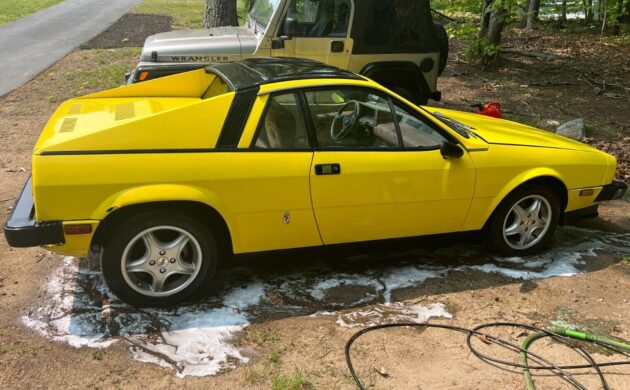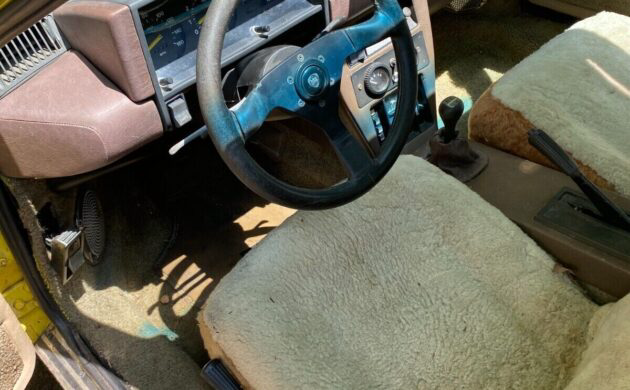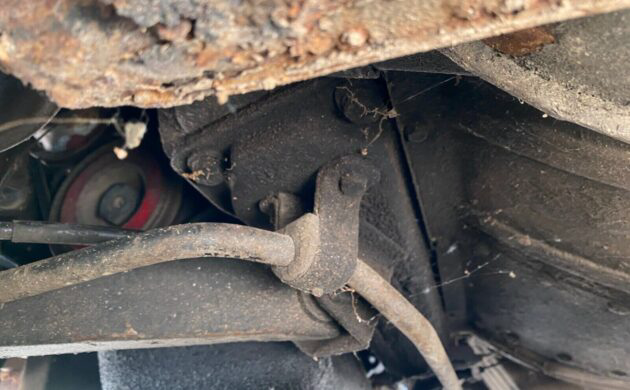A shocking thing has happened. The previously disrespected Lancia Scorpion has begun to beguile collectors. Now I know I am going to hear some arguments about how great this car is/was, but I like to listen to markets, and frankly, the Scorpion simply did not set the barn on fire with its sales numbers. Introduced as the Montecarlo in Italy in 1975 and entirely designed by Pininfarina, the car was originally commissioned by Fiat. When Bertone stepped in with a cheaper alternative that became the X1/9, Lancia inherited the project. In the end, the Montecarlo was made in several series and exported to the US as the Scorpion until 1981 (with a one-year hiatus in 1979), but only 7575 cars were sold in six years. Far fewer survive. The car was more expensive than a Porsche, the S1’s brake design was poor, regulations slammed the engine’s power output, and the car’s areas of double-skinned sheet metal rusted with abandon. Yet, as time passes the heart grows fonder, and now good examples of these slightly odd Lancia’s are selling for nearly $30k. You can venture into Scorpion territory here on eBay where this 1976 example is bid to only $5150 with no reserve. Located in Concord, New Hampshire, it runs and drives.
The original engine was a wheezing rear-mounted 1.8-liter four-cylinder generating just 85 hp. This knowledgeable seller has upgraded his car in all the right ways, starting with a 2.0 liter breathing through a Weber DCD carburetor set on a custom manifold. The front brake servo has been removed, helping to balance the braking system front to rear. The car has electronic ignition and a recent clutch. The seller suggests replacing the timing belt due to the passage of time. One stud broke in the exhaust header so it’s wearing two gaskets for now.
The interior is faded, the original leather seats are worn, and apparently, a previous owner didn’t fix the driver’s seat recliner, so there is a dent in the rear panel. The recliner mechanisms do work now. The sheepskin seat covers could use a bath. The leather after-market steering wheel is cracked along the top (it would be worth sourcing the distinctive two-spoke factory wheel). The trunk still contains the original jack, but the carpet is torn. The folding top should slide to store under the rollbar/C pillar; the seller notes that the straps broke and were replaced with hinges.
The body was repainted from blue and has a few flaws as the seller points out, including rust bubbling here and there. The floor pans and the remainder of the underside are said to be in good shape; it’s hard to know given limited photos whether the crustiness above is truly troublesome or just dirt. While this car does pose a few challenges, help for new owners is available here and here. What do you think, is this Pininfarina-designed car a bargain, or a bust?






This is written with a slanted view, negatively, and should not be. The Lancia brand is a well-known brand that has many years of championship rallying accredited to its well designed, engineered autos. They were a major threat to Ferrari with many ex-employees working at Ferrari in subsequent years.
The brand suffered in the seventies because of the times, not poor-quality autos. Check Lancia history and record sales prices…. Stratos, 037, Martini racing, Aurelia Series….all excellent investments and very high-quality builds.
I own a Lancia Spider …. now worth north of $500,000 and presently own a Scorpion/MonteCarlo. The model shown here does have rust issues.
Leno’s favorite car company is Lancia. But Leno will be the first to tell you rust is a serious consideration for Lancia, as with all European cars of 60’s – 2000. They only applied primer and paint diligently to what your eyes can see unfortunately. It’s baffling. It makes no sense. If paint was in short supply, slow production until it’s on hand. It’s as important as the motor. You shipping cars without motors? NO! So please never ship cars to USA without comprehensive RUST PROOFING. That said, pretty car. Fun car. Too yellow. Full restoration and get rid of the rust properly. It will hold value only if it’s done properly.
I didn’t read it as negative towards Lancia. Negative to the U.S. spec Scorpion yes, and author is correct, while a cool concept, it was underpowered in US spec form, with about 80 HP when you could get 100 plus in a Porsche 924 or RX7 which weighed about the same. Therefore, as stated, they didn’t sell well when new. Lots of cars that are considered cool an collectible now started out on a similar path. I agree with you that Lancia has great history and cache as a brand, but not so much here in the states, and maybe less so in Europe now that they have been selling badge engineered low end offerings for the last few decades.
Not true. My 924 had 85 hp. 85 hp was not uncommon in cars at the time.
I certainly didn’t take the article with a negative slant on Lancia. Truth be told US Lancia Scorpions were crap plain and simple. I have told this story in the past but my fellow Alfa tech had a beautiful one for sale that he would not sell me. He said I would not be happy with the lack of power and crappy brakes. I love Lancia, Alfa, as well as Maserati. Have worked as an Alfa tech and with each make some of the cars we got on this side of the pond were crap! I think Michelle did a great job with the article.
The Monte Carlo on the other hand was a good car in spite of its brake shortcomings which could be corrected and was later on.
Can we have additional pictures of the known rust areas? Anyone out there, what are the don’t touch this car fatal rust areas’?
Please check the actual listing on eBay, linked in the article. The seller does a great job lining out the rusted areas. Rusted turrets are difficult to repair, so check the entire underside.
There are many Italian cars that look great in yellow. This is not one of them.
I was going to say this. It looks like a banana.
It’s not helped by the solid rear buttresses (later cars had glassed-in flying buttresses), the body-color painted noseband (stock nosebands were a metallic graphite color), and the missing wide black stripe that continued the bumper line along the lower flanks as stock, all of which conspire to make the car look slabby and stumpy. IMO yellow works better on curves and smaller spans of undivided surface.
Rust is the killer, look at the last picture, and seat frames made of cheap plastic tended to break, and that were the eightiees! So cool car but buyer beware.
kind regards Thomas from Tyrol
I have a Lancia Zagato 1982 great little fun car , not to fast ,but fun to drive on twisty country roads here in Washington ,they have good engines if looked after . I bought mine of a insurance company with a small dent on the drivers side rear panel, I a mechanical engineer & i had the tools to beat it out my hand .I rebuilt the engine & installed a new clutch while i had the engine/ subframe out. Allis good now. Love Lancias and my old MGBs.
I have the tool and beat it out my hand too! Sometimes it’s the best I can do-
This could be a fun driver if rust doesn’t turn out to be a problem. Whoever thought that pulling the front brake servo out was going to balance the brakes knows nothing about brakes. That servo has a valve in it that balances out the front and rear brakes, just like every single car on the road today. Not sure which way the servo adjusted the bakes but I’d bet hard braking on a wet road would be a thrill a second until it spun out. We use adjustable proportioning valves on our race cars to balance our brakes for high speed slowing for curves.
Scorpicarlos didn’t have the proportioning valve to adjust front-rear brake bias depending on cargo load, but other Fiat and Lancia models of the era did.
The S1 Scorpicarlos were inexplicably equipped with vacuum-boosted power disc brakes only in front, leaving the rear discs unboosted. Amazingly, this bizarre setup wasn’t just a matter of being too cheap or can’t-be-arsed to develop a fully-boosted system; rather, we can infer it was quite deliberate, as they engineered a rather byzantine system to accomplish this, diagrammed here:
https://www.lanciamontecarlo.net/images/brake_circuit.gif
With the engine, fuel tank, and spare tire all in the rear, the front wheels didn’t have much weight keeping them planted, allowing those power front brakes to lock up a bit too readily when driven in anger in the wet or when road traction was otherwise marginal, which the motoring press made great sport of ridiculing, perhaps more than was likely to actually affect most owners day-to-day.
Fortunately, it’s a fairly simple matter to bypass the vacuum boost if one is so inclined (The Monte Hospital offers a ready-made kit for it), and X1/9 brake upgrades such as the popular Whoa! Brakes retrofit kit using Wilwood calipers are an easy nut’n’bolt swap. S2 Montecarlos omitted the brake booster entirely and upgraded to larger 14″ wheels allowing for larger discs, though the US Scorpion variant sadly would not resume production by that time.
Yes it has to be pulled out and properly bypassed. The servo was in the front and the engine was in the rear. It was not a good combination.
Is it possible that bobhess knows less about brakes than he thinks he does? Specifically, the first series Montecarlo/Scorpion had boosted front (disc) brakes and unassisted rear (drum) brakes. If you know enough about automotive braking systems, you can understand why this seemed like a good idea on a paper, to the engineers who came up with it. But it didn’t work well in practice, with premature front lock-up on slippery surfaces being the most common complaint, so the quick ‘fix’ is to disable the (fronts-only) servo and run the whole thing unboosted. (That said, I’ve never driven one, so I too would worry about the risk of rear lock-up from this crude mod.)
And, in the interest of complete/correct pedantry, bobhess is also wrong about modern brake servos containing a front/rear proportioning valve; if you have one pneumatic (vacuum) servo acting on one dual-circuit master cylinder (common—but not universal—practice since the ‘60s, with the subject car being an obvious exception), any dynamic proportioning happens downstream of the MC in the hydraulic part of the system.
A few minor clarifications:
These had 4-wheel disc brakes shared in common with the X1/9, not drums for the (unboosted) rears.
Also, the vacuum servo for the boosted front brakes was mounted remotely, in the rear engine compartment rather than at the master cylinder for the pedal. This makes sense for maintaining airtight vacuum but required engineering a rather byzantine system to achieve it:
https://www.lanciamontecarlo.net/images/brake_circuit.gif
As Joe said here, that may have “seemed like a good idea on paper”–in that the front brakes in any vehicle perform most of the work due to momentum transfer under braking–but the engineers responsible apparently overlooked the factor of tire traction on the road surface.
I suspect those may have been somewhat novice Pininfarina-associated engineers, as this was Pf’s first attempt to develop an entire car in full, and Lancia engineers (who stayed on after the Fiat buyout) were among the best the industry has ever seen and would have been well aware of that factor.
With nearly all the weight in back (engine, fuel tank, spare tire), there wasn’t much weight in front to keep the front tires planted on the road, and thus not much resistance to caliper lockup, especially in wet/icy conditions. And when the front brakes lock up, suddenly you have no steering until you let off the brakes, which is counterintuitive in a panic scenario!
Oops; I think I misspoke when I said rear drums—pretty sure these have discs all-around (making the unassisted rears even more unorthodox) and I was picturing a slightly different schematic (Fulvia??). Sorry for any confusion.
Still disrespected here, and the pictures show the owners disrespected it too, Dirty, rusty, horrible interior, Playskool wheel. Except for the rally cars Lancia quality was in the toilet after the Fiat takeover. There is NO comparison between this fright pig and an Aurelia. NONE.
A few clarifications:
The Montecarlo was produced in only two series, ’75-78 and ’80-81, but the American-market Scorpion version (rebadged because Chevy already owned the “Monte Carlo” trademark here) was only imported here for ’76 (with solid rear buttresses, as seen here) and ’77 (with glassed-in flying buttresses, which continued until the end of production).
The FWD Lancia Beta (which provided the transverse powertrain for these) was produced in several series from ’72-84, but only imported to the American market from ’75-82, skipping ’80 while Fiat-Lancia ramped-up production and US-DOT certification of a new Bosch L-jet FI system.
The series 1 Scorpicarlos were badged and marketed as “Lancia Beta Montecarlo” (or “Lancia Beta Scorpion” here) because of the common Beta powertrain, lending the Beta family some extra sporting cachet, and to help “sell” the notion of these being a Lancia when most of the rest of the running gear under the skin was shared in common with the X1/9. This early model branding can lead to some conflation of details between the FWD Lancia Beta models vs. the mid-rear engined Scorpicarlo. S2 Montecarlos dropped the “Beta” from their model name.
These also have a rather fascinating development history—in a nutshell:
Fiat wanted a replacement for their aging 124 Sport Coupe, so they solicited proposals from Pininfarina and Bertone, under Fiat internal development project codes X1/8 and X1/9 respectively. Bertone’s X1/9 proposal got approved, retaining its codename for the actual production model.
Pininfarina wasn’t ready to give up however, as their X1/8 bid had become a bit of a pet project for them, being their first attempt to fully design and develop an entire car (not just body shells) for in-house series production, aside from the powertrain and running gear to be provided by Fiat. Originally intended to have a 3-liter V6, this was scaled back to a 2-liter plan when the ’70s oil crisis hit, and the project was re-designated as X1/20.
Fiat had also recently acquired Carlo Abarth’s tuning/racing shop, which they tasked with developing a couple early prototype X1/20 bodyshells into racers to compete in the Giro d’Italia for promotional and “racing improves the breed” purposes. These became the Abarth 030, equipped with an Abarth-tuned version of the 3.2L V6 from the Fiat 130, mounted longitudinally to a ZF transaxle. One of these finished the competition second only to the mighty Lancia Stratos; the other 030 was a backup/display car and never raced. This project would continue, ultimately culminating in the Lancia Rally 037.
That racing effort aside, the series-production side of the X1/20 project was eventually transferred under Lancia’s wing, Fiat having saved that storied firm from looming oblivion in late 1969 by acquiring it for a token 1 Lira per share. As the X1/9 had proven the viability of putting a series-production transverse FWD powertrain (from the Fiat 128) into a rear-mid engine configuration, Fiat recognized they could do the same with the new Lancia Beta’s FWD powertrain for the X1/20 and thus market it as a Lancia, which would also justify other comfort, equipment, and refinement upgrades to better distinguish it from the X1/9 and position it upmarket for a more profitable price tag.
Ultimately, the production car became the first series-production model to be fully manufactured to completion entirely in-house at Pininfarina, just as they’d hoped and planned for all along.
You are correct to point out it was Abarth who developed and ran all the competition Lancias post Stratos. That includes Le Mans type Lancia Beta Monte Carlo Turbos and Gp5 prototypes, 037, S4, Delta Integrale and EVO rally cars etc
Stratos itself was a skunk works design by d’Allara with Ferrari Dino engine.
Other than badging there’s very little Lancia in the halo cars! Not to say the Fiat era cars were bad cars. Before that, the Fulvia was nice enough, but you have to go back 70 years ( B12, B20 Aurelia series) to find Lancias with the quality to match the myth. And they were extremely expensive in their day.
Well done, SUBGothius!!!! Nice to see intelligence write and pass on to those not as fortunate!
Lancia was once the Itailin powerhouse easily rivaling Alfa Romeo, building exquisite sedans and convertibles of uncommon grace. Mussolini´s parade car was a Lancia Years ago I saw it in the Imperial Hotel´s museum on the Vegas strip.
Ended:
Aug 30, 2023 15:47:47 PDT
Winning bid:
US $6,700.00
[ 25 bids ]